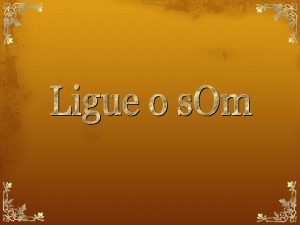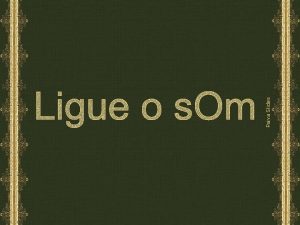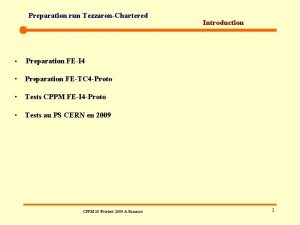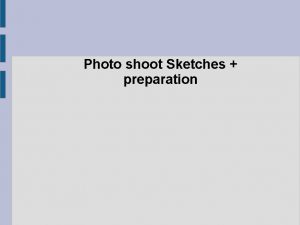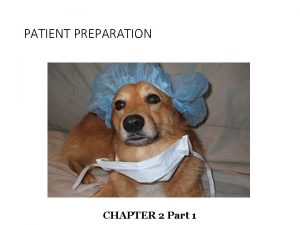Slides Preparation Slides preparation is an important part

















- Slides: 17

Slides Preparation

Slides preparation is an important part in many areas of biological, medical, veterinary and forensic sciences and you will often be required to prepare different kinds of slides Specimens may be smears of fluids, thin sections or whole mounts of all or part of an organ or organisms. In all cases the material is mounted on a glass slide prior to its examination

Mounting The mounting of specimens on microscope slides is often critical for successful viewing. This issue has been given much attention in the last two centuries and is a well-developed area with many specialized and sometimes quite sophisticated techniques.

Dry mount In a dry mount, is the simplest kind of mounting, the object is merely placed on the slide. A cover slip may be placed on top to protect the specimen and the microscope's objective and to keep the specimen still and pressed flat. This mounting can be successfully used for viewing specimens like pollen, feathers, hairs, etc. It is also used to examine particles caught in transparent membrane filters (e. g. , in analysis of airborne dust).

Wet mount or temporary mount These preparations may be needed for matter of minutes or hours only. They are mounted in water or glycerol or other fluid. After examination they are discarded. The material under examination can be fixed and stained or even examined in a living state. In a wet mount, the specimen is placed in a drop of water or other liquid held between the slide and the cover slip by surface tension

To view microscopic organisms that grow in pond water or other liquid media, especially when studying their movement and behavior. Care must be taken to exclude air bubbles that would interfere with the viewing and hamper the organisms' movements.

In case of examination of a protozoa such as amoeba. a harmless aqueous stain such as 1% methylene blue can be used – it would then be known as a “vital stain”. If it is necessary to keep the slide for a matter of hours it is possible to reduce evaporative losses from the edges of the cover-glass by painting a ring of gum or molten wax or nail polish around its edge.

permanent mount If the slide is to be kept for long-term reference, for a matter of days or even years, it must be made as a permanent preparation. For pathological and biological research, the specimen usually undergoes a complex histological preparation that may involve cutting with a microtome, fixing it to prevent decay, removing any water contained in it, staining specific parts of it, clearing to render it transparent, impregnating or infiltrating it with some transparent solid substance. As part of this process the specimen usually ends up firmly attached to the slide.


Strew mounting describes the production of palynological microscope slides by suspending a concentrated sample in distilled water, placing the samples on a slide, and allowing the water to evaporate

Mounting media The mounting medium is the solution in which the specimen is embedded, generally under a cover glass. Simple liquids like water glycerol can be considered mounting media, though the term generally refers to compounds that harden into a permanent mount.

Popular mounting media include Permount , glycerol jelly, Hoyer's mounting medium

Properties of a good mounting medium include 1 - having a refractive index close to that of glass (1. 518), nonreactivity with the specimen, 2 - stability over time without crystallizing, darkening, or changing refractive index, 3 - solubility in the medium the specimen was prepared in (either aqueous or non-polar, such as xylene or toluene), 4 - not causing the specimen stain to fade or leach

Labelling of slides Slides act as a permanent record of tissues, organs and specimens. They may be of pathological origin, e. g. hospital patients, prepared “in house”, etc. In all cases it is essential that the slide is properly identified by adequate labelling. Labels should therefore carry the following information: 1. The name of the organism – if the whole organism is mounted then the slide can be marked WM=whole mount or E=entire 2. The part of the organism used, e. g. liver, root. 3. The type of preparation, e. g. smear; squash; TS = transverse section; VS = vertical section; LS = longitudinal section.

Labelling of slides Slides act as a permanent record of tissues, organs and specimens. They may be of pathological origin, e. g. hospital patients, prepared “in house”, etc. In all cases it is essential that the slide is properly identified by adequate labelling.

Labels should therefore carry the following information: 1. The name of the organism – if the whole organism is mounted then the slide can be marked WM=whole mount or E=entire 2. The part of the organism used, e. g. liver, root. 3. The type of preparation, e. g. smear squash TS = transverse section VS = vertical section LS = longitudinal section.

Storage of preparation slides Prepared permanent slides are valuable. They are widely used by educational establishments in the teaching of histology (the study of tissues of plants and animals) and cytology (the study of cells). In some cases the preparation may be uniquely valuable. It could for example be an important reference slide or a slide of the diseased tissues of a hospital patient.
 Newspaper article format
Newspaper article format Inverted pyramid in news writing
Inverted pyramid in news writing Least important to most important
Least important to most important A small child slides down the four frictionless slides
A small child slides down the four frictionless slides Each of the boxes shown is pulled for 10 m
Each of the boxes shown is pulled for 10 m Most important part of the body
Most important part of the body The mass media play an important
The mass media play an important Part part whole addition
Part part whole addition Unit ratio definition
Unit ratio definition Part part whole
Part part whole What is a technical description
What is a technical description What are the parts of the bar
What are the parts of the bar The phase of the moon you see depends on ______.
The phase of the moon you see depends on ______. 미니탭 gage r&r 해석
미니탭 gage r&r 해석 Crucifixion quotes gcse
Crucifixion quotes gcse Footwork in netball
Footwork in netball Items that distort or prevent communication
Items that distort or prevent communication What i learned about work immersion
What i learned about work immersion


















